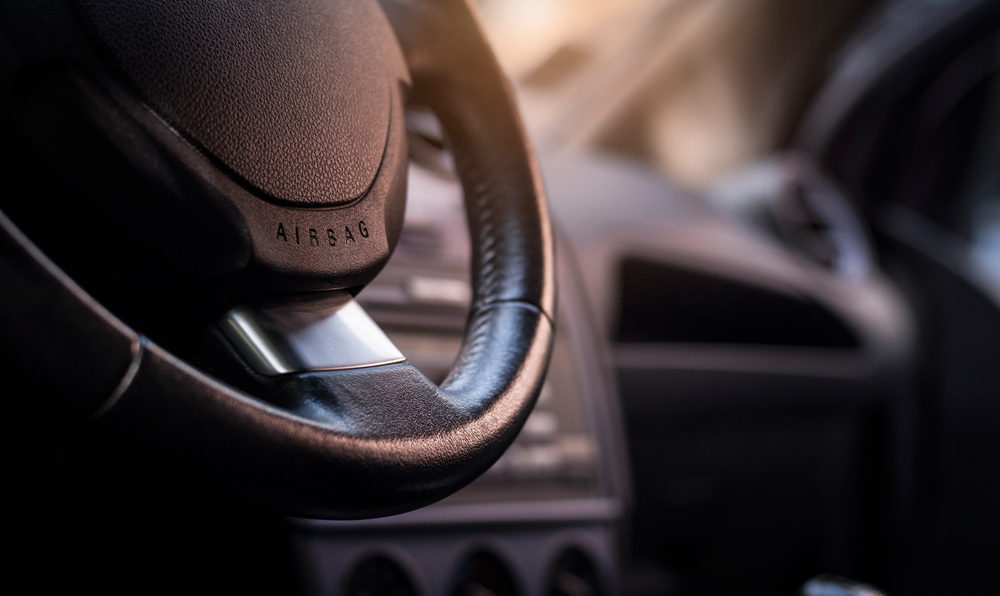
Airbags are designed to protect you in the event of a car crash, and they are very effective at doing this. However, in preventing serious injuries, the airbags themselves can actually cause other injuries because of the force with which they deploy. While chest pain can be associated with other car accident injuries, it is often a sign that the airbag has had an impact on your body. This may be harmless, but it can also be a sign of more serious problems, so it is best to seek medical care to rule out anything life-threatening and begin treating your injuries.
How Airbags Work
Airbags are created using a light fabric that is stored in the car’s paneling, in the steering wheel, or a panel on the passenger side of the dashboard. The driver’s airbag that sits in the steering wheel is about the size of a large beach ball when fully inflated, while the passenger’s is larger to make up for the fact that it deploys from further away. Some cars also have airbags in vehicle doors, including the back seat, that will deploy in a side-impact crash, though this is not required.
A crash sensor is used to tell the airbags when to deploy after a threshold of impact has been met. This usually occurs when there is a head-on or nearly head-on collision at speeds of over 10 miles per hour. If the crash is severe enough, it may also trigger an igniter to produce a gas, like nitrogen or argon, to fill the airbag and deploy. This entire process occurs in about 1/20th of a second. Almost immediately, the airbag will deflate, which may release dust and chemicals into the air.
It is possible for the crash sensor to malfunction and cause an airbag to deploy when it should not or not deploy when it should. An airbag that deploys even a fraction of a second too late could have severe consequences, so they are generally strictly regulated.
Along with airbags, seatbelts can also cause injuries as a part of their design, and these may sometimes interact. The forceful tightening of a seatbelt may prevent you from colliding with an airbag but cause similar abdominal problems.
It is critical to keep your seat the recommended distance from the steering wheel relative to your height. When this isn’t done, the airbag may be too close or too far to be protective and can cause additional damage. The seatbelt and steering wheel itself can also pose dangers in these instances. The recommendation is that your seat should be approximately ten inches from where the airbag would deploy. You can also prevent airbag injuries by properly using a seatbelt and ensuring that children are in the proper location and using the proper restraints.
Other Common Airbag-Related Injuries
 Any body part that is exposed to an airbag is at risk of injury from deployment, and if gas or chemicals is involved, other complications can occur. While the chest is an area that is commonly impacted, other injuries are common during an airbag deployment.
Any body part that is exposed to an airbag is at risk of injury from deployment, and if gas or chemicals is involved, other complications can occur. While the chest is an area that is commonly impacted, other injuries are common during an airbag deployment.
Face Injuries
Because airbags are positioned near the top of your body, the face is often at risk of injury. One of the goals of an airbag is to prevent your face from coming in contact with the windshield, but the force used to do this can strike your eye or even fracture the fragile bones in your face. Eye damage and even blindness are possible, as well as head injuries like a traumatic brain injury.
Neck and Back Injuries
Your spine, particularly the upper portion known as the cervical spine and neck, is vulnerable to airbag injuries as well. The airbag stops your body from being thrust forward on impact, but it is still possible for soft tissue to be damaged, leading to whiplash. Even without the traditional sudden jolt associated with whiplash, it is still possible this damage occurred.
Burns
Both physical and chemical burns are possible during an airbag deployment. The speed of the airbag can cause surface abrasions and burns to the skin, especially the face and arms. This is similar to a rug burn but results from an airbag. The chemicals released during inflation and deflation can also cause eye and skin irritation that may result in chemical burns.
Internal Injuries
In addition to burns, the chemicals associated with airbags can irritate the lungs and may even trigger asthma attacks. But the main concern related to internal injuries comes when the abdomen is subjected to the pressure of an airbag.
Enough pressure on the abdomen may damage the organs, causing lacerations to the liver, spleen, lungs, and heart. Severe cases may end in internal bruising or bleeding that requires surgical intervention.
Chest Injuries from Airbag Deployment
 When the airbag places pressure on the chest, it can cause injuries to that area, though this is somewhat rare. Some chest injuries may be mild or surface-level, while others are cause for more concern.
When the airbag places pressure on the chest, it can cause injuries to that area, though this is somewhat rare. Some chest injuries may be mild or surface-level, while others are cause for more concern.
A chest contusion is any injury caused by a blow or external force which doesn’t break the skin but injures the blood vessels or tissues beneath the skin. This can sometimes result in a bruise but may also have complications that cause internal injuries and require medical intervention.
Injuries commonly related to a chest contusion include:
- Myocardial contusion: A bruise on the heart, which can impact the nerves and muscle tissue. This would impact the heart’s ability to contract and pump blood through the body. A severe enough case could result in immediate death.
- Pulmonary contusion: This affects the lungs and can be uniquely dangerous because the injured person may not notice there is a problem right away. In the meantime, blood and fluid can build up in the lungs and reduce the amount of oxygen the blood receives. Without proper treatment, the consequences of a bruised lung can be fatal.
- Broke ribs: Enough blunt force on the chest could break one or more ribs. In most cases, this is similar to breaking any other bone, though they cannot be treated with a cast. Broken ribs can heal over a period of months. A common complication is pneumonia, but the real risk comes when a broken rib punctures an organ, especially a lung, causing bleeding and other problems.
- Pneumothorax: This is another term for a collapsed lung, which occurs when air or fluid leaks into the space between the lung and the chest cavity. This air or fluid puts pressure on the outside of the lung, causing it to collapse.
- Hemothorax: When blood pools between the chest wall and the lung, usually as a result of blunt force or a broken rib, this is known as hemothorax. It often occurs simultaneously with pneumothorax.
Diagnosing Chest Injuries After a Car Accident
 Many people assume a chest contusion is simple and even harmless, like any bruise. However, it can be deceptive as the force does not break the skin, leaving no external indicator that an injury has occurred. It’s common for someone not to realize they have suffered a true injury.
Many people assume a chest contusion is simple and even harmless, like any bruise. However, it can be deceptive as the force does not break the skin, leaving no external indicator that an injury has occurred. It’s common for someone not to realize they have suffered a true injury.
When a patient presents with any of these symptoms, doctors will need to assess the extent of the injury and rely on various diagnostic imaging tests to make a diagnosis. Some ways they may do this include:
- X-Rays: A standard x-ray will take a static photo of an individual’s bones, including the chest, in order to diagnose fractures to the ribs or clavicle. These are less accurate for other injuries but can be used to rule out these conditions.
- MRI (Magnetic Resonance Imaging): This scan uses magnets and radio waves to create detailed pictures of the inside of the body. A lack of radiation makes these a safe method to identify soft tissue injuries, though they take a long time to conduct and may not be ideal in potentially life-threatening situations.
- CT Scans: Much faster than an MRI, a CT scan uses radiation to create images of the body. They are particularly effective at diagnosing lung issues.
- Ultrasounds: As a non-invasive option, ultrasounds may be the first way doctors attempt to diagnose lung injuries. The use of sound waves allows ultrasounds to create live images of the body in real-time.
- Surgery: In extreme circumstances, doctors may need to perform exploratory surgery to fully understand the extent and cause of any injuries.
What to Do After an Accident
If you’ve been in a car accident, it is important you always seek medical attention as soon as possible, even if you do not think you have suffered any injuries. Many car accident injuries, including those involving the chest, have delayed symptoms and may not be apparent for hours or days after the accident. During that time, the problem is worsening and you are not able to address it. Visiting a skilled provider right away will allow them to diagnose the injuries and begin treating them right away.
In the case that you are experiencing chest pain after an accident, it is even more important to seek medical attention promptly. Intense pain can indicate a severe injury, but even mild symptoms may be associated with serious conditions. Left untreated, these effects can be fatal or lead to lifelong complications.
You should first work with the first responders who are at the scene of your accident. They will be able to do a simple assessment for serious injuries and ensure your immediate safety. If they suggest you are transported to a hospital via ambulance, it is always best to allow them to do so. At the hospital, you can be fully evaluated by the emergency staff for any urgent issues. If there is any sign of chest injury, they may keep you for observation.
Even if you are not transported via ambulance, if you are worried that airbags caused serious damage, you can visit an emergency room. They will be able to rule out the serious conditions that require attention right away, and you can then seek out the proper professionals for ongoing treatment.
Treating Chest Injuries
The treatment for chest pain and injuries will depend on what the underlying cause is determined to be. For example, simple bruising will heal on its own and be managed with ice, heat, rest, and over-the-counter medication. More serious issues like a collapsed lung or internal bleeding will require much more invasive treatment like surgery, monitoring, or oxygen therapy.
If you have ruled out emergent conditions that require care, you may be left to manage other side effects of your injuries. Back and neck injuries, broken bones, and whiplash may all require a combination of chiropractic care, physical therapy, and other treatments that can be used as a long-term plan for recovery.
Injuries that may be missed by first responders and even emergency rooms are often what bring people to the chiropractor. They will be able to focus on alignment in the spine and helping the body return to its natural, healthy state to reduce inflammation and other symptoms of tissue or bone damage. If your movement has been impacted by your injuries, physical therapy can help by focusing on restoring range of motion and strength to the body. If necessary, a pain management specialist will work with this team to ensure recovery is possible without pain.
Orthopedists and neurologists may also work with these teams as necessary to perform more invasive procedures or help to diagnose additional problems found throughout treatment.
At AICA Snellville, we have all of these professionals and more on our team. The holistic approach to care allows us to create comprehensive and personalized treatment plans for each patient we see. After a car accident, if you are experiencing chest pain and have ruled out life-threatening conditions, contact AIC Snellville to begin working towards total recovery.
